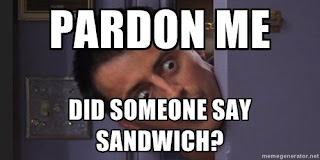I hate having to tell people what they did wrong. It’s hard and I don’t like disappointing people. And that is one reason why writing is so great--it’s subjective. Writing doesn’t have a lot of right and wrong to it. So when you critique you can focus on feedback that is telling the writer what’s not working for you as the reader. That said, if feedback isn’t delivered with care, it can be debilitating to a writer, especially one just starting out. This is why I love the sandwich method.
Yes I said sandwich, but unfortunately it’s not the eating kind. It’s the critiquing kind. So let’s decompose the sandwich method. In a standard sandwich you have the bread and the meat/veggie center. The bread is the good part. It’s got to be there otherwise you can’t have a sandwich. So when you critique someone it’s always helpful to start with something you liked about their work. Between characters, concept, story, setting, voice etc. you should be able to find something good about the work you are critiquing.
After first slice of bread comes the core of the sandwich. This is where you need to decide if you are a turkey sandwich, a ham sandwich, a BLT or something else. (I’m starting to get hungry) What goes on the sandwich is the things you want to discuss, what worked, what didn’t what might need some tweaking etc. You may choose to make this a turkey sandwich only and focus on just one issue that needs a lot of work, or you may decide you want a turkey with all the fixings, in which case you might discuss a lot of things you noticed. Just make sure you pile that sandwich with care. If you put the wrong combination of items it might not taste good. Or if you pile too high, the whole sandwich might topple over. Just like this…
I
know that’s a bacon sandwich and what could honestly be wrong with bacon, but
look at the structural integrity of that sandwich (sorry, I’m an engineer).
That thing is a few strips of bacon from toppling onto that dirty table, and
who wants gross bacon? Certainly not me. The same goes for meat of the
feedback. If you pile too much on at once you risk knocking over the writer’s
feelings. People have a threshold on how and what they can handle, so make sure
you aren’t serving them a sandwich they can’t eat.
Yeah, I know, it’s all about the bacon. But you
can’t have a sandwich without the top piece of bread. And that bread is again
the good stuff. (Yes better than the bacon I SWEAR!) So make sure you cap off
your feedback by again saying something nice. Start with good and end with
good. If you do that, you’ll reel the writer in with what they really need to
focus on without crippling them. Otherwise you might end up like this guy…
And
we all know things didn’t turn out so great for him. So stick with the sandwich
method. It allows you to deliver feedback in a nice way that will help the
writer see what needs work without sending them home sad and hungry.
How
do you like to give and/or receive your feedback?





12 comments:
Nice metaphor for the aspects of productive critiquing..
thanks! :)
Excellent analogy! I will for sure remember to offer advice by starting with good, ending with good,, and not overloading the middle! 🍔 Thanks!
your welcome! :)
That is one scary sandwich up there^...
I discovered the sandwich method before I got or gave writerly critiques. My kids swim coach explained to me why he was so effective at getting them to refine and improve their strokes. He used the word sandwich, and then I watched him in action. Seeing how much better kids listened to him taught me a lot.
Some critiques confuse "I liked it" sort of comment to begin and end with as employing the sandwich method. That's nice, but not real feedback. The bread part should be genuine specific "what works" and the meat should be "what could be improved."
I agree. It's good to be positive but you also need to be specific. What did you like specifically, what didn't you like specifically. Even if you can put your finger on why, something like I didn't like this cause it doesnt seem to fit but i cant really put my finger on why is okay. all good points
The sandwich method is a great idea. One of the frustrating things about writing is indeed that it's so subjective. When someone asks "Is this good?" The question is often unanswerable.
Bahaha that last meme.... ahahaha!
yes that definitely makes things tricky but we all carry on in hopes that our work finds it to the right reader :)
haha right? so awesome!
I try to always use the sandwich method, too. Great explanation of how it works!
thanks! :)
Post a Comment